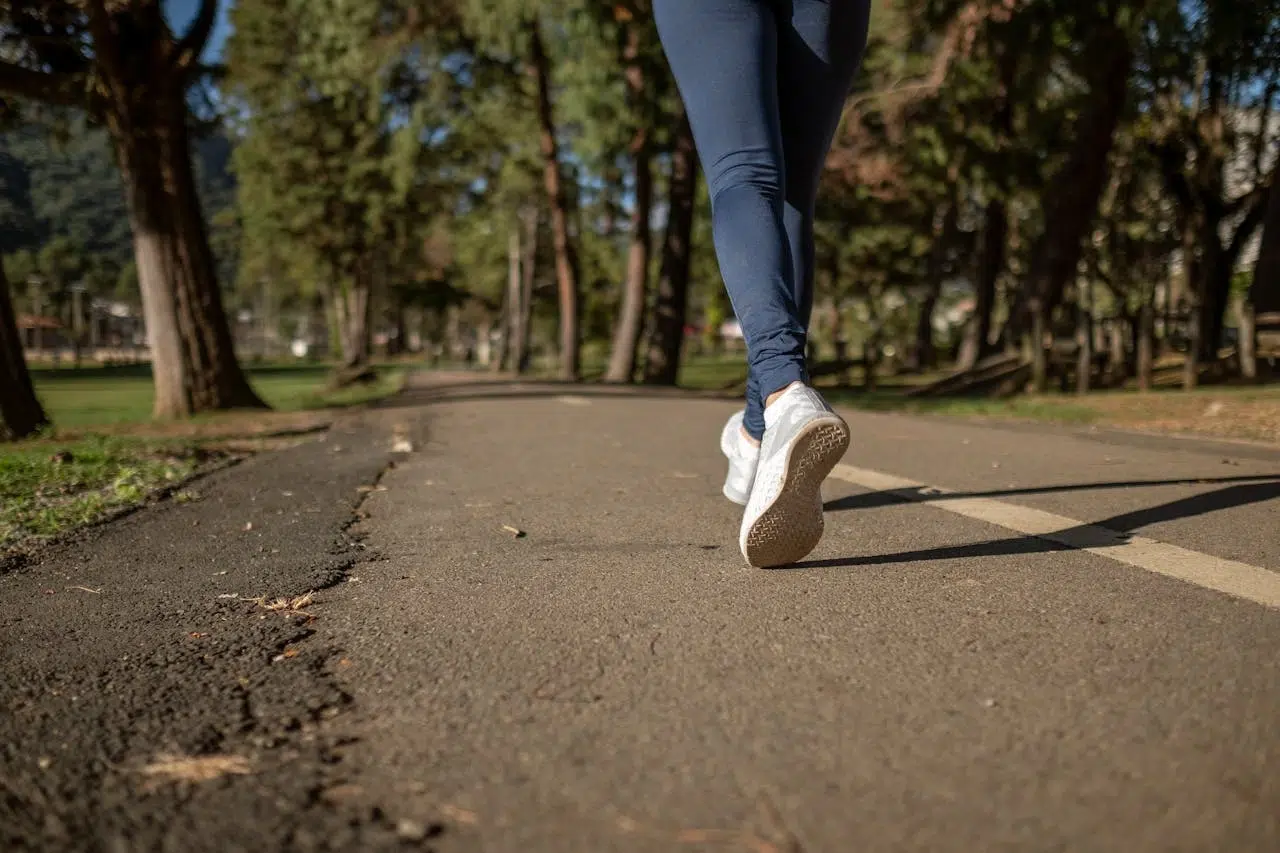
Is Your Current Exercise Routine Truly the Best for Your Health? Choosing between walking vs running can be challenging, as both exercises offer unique health benefits.
In this article, we’ll explore the key differences between walking and running, helping you decide which exercise aligns better with your fitness goals. Understanding the benefits of each can transform your fitness journey and lead to a healthier lifestyle.
Both walking and running are excellent for improving heart health, boosting metabolism, and enhancing overall well-being. By identifying the right activity for your needs, you can maximize these health benefits effectively.
Key Takeaways
- Walking and running provide different health benefits for various fitness levels
- Individual health goals determine the most W exercise approach
- Both activities contribute to cardiovascular and mental health improvements
- Personal fitness level plays a crucial role in exercise selection
- Understanding biomechanics helps prevent potential exercise-related injuries
Understanding the Fundamentals of Walking vs Running Exercise
Exercise is key to staying healthy. Walking and running are two basic exercises that work our bodies in different ways. Knowing how these movements work can help us pick the best workouts.
Our bodies move in different ways when we walk and run. Each has its own mechanics that affect our fitness and health.
Core Mechanics of Walking
Walking is a low-impact activity with a unique movement pattern. Our body stays in touch with the ground, making a smooth motion.
- Stride length is usually 2-3 feet
- Heel strikes the ground first
- It uses less energy than running
Running Technique Preliminary
Running is more dynamic and uses more energy. The main difference is in how our feet hit the ground and our body’s position.
- It has more vertical movement
- Ground contact time is shorter
- More muscles are engaged
Repercussion on Body Movement
Walking and running both work many muscles, but in different ways. Here’s how they compare:
| Movement Aspect | Walking | Running |
|---|---|---|
| Muscle Engagement | Low to Moderate | High Intensity |
| Calorie Burn | 30-50 calories/mile | 80-100 calories/mile |
| Joint Impact | Low | High |
“Movement is medicine for creating change in a person’s physical, emotional, and mental states.” – Carol Welch
Knowing these differences helps us pick the right exercise for our goals and health.
Health Benefits of Walking: A Comprehensive Overview

Healthy Routine
Walking is a powerful daily exercise that benefits everyone, no matter their age or fitness level. It’s a simple yet effective way to stay active. Walking offers many health benefits that go beyond just moving around.
Let’s look at the amazing health benefits of walking:
- Cardiovascular Health: Walking strengthens the heart, lowers blood pressure, and boosts circulation
- Weight Management: It burns calories and keeps metabolism healthy
- Mental Wellness: It reduces stress and improves mood by releasing endorphins
- Bone and Muscle Strength: It supports joint health and builds muscle endurance
“Walking is man’s best medicine.” – Hippocrates
Studies show that consistent walking can greatly lower the risk of chronic diseases. Our bodies love this low-impact exercise. It’s perfect for keeping us healthy in the long run.
| Walking Duration | Potential Health Benefits |
|---|---|
| 15-30 minutes daily | Improved cardiovascular fitness |
| 30-45 minutes daily | Weight management support |
| 45-60 minutes daily | Reduced chronic disease risk |
Our bodies are made for movement, and walking is a great way to stay healthy. Whether you’re into fitness or just starting out, walking is a great choice. It’s a lasting way to improve your health.
The Science Behind Running’s Impact on Health
Running is more than a physical activity. It changes our body from the inside out. It shows how running can improve our health in many ways.
Looking into the science, we find amazing facts about running’s effects. It does more than just make our heart stronger.
Cardiovascular Transformation
Running makes big changes in our heart and blood system. Our heart gets stronger and pumps blood better. These changes include:
- Increased heart muscle strength
- Enhanced blood circulation
- Reduced resting heart rate
- Lower risk of heart disease
Metabolic Enhancements
Running also changes how our body uses energy. These changes help us burn calories better and use fat more efficiently. They include:
- Accelerated calorie burning
- Improved insulin sensitivity
- Enhanced fat metabolism
- Increased mitochondrial efficiency
Muscular Development Insights
Our muscles change a lot with regular running. It works many muscles, especially in our legs and core.
| Muscle Group | Running Impact |
|---|---|
| Quadriceps | Increased strength and endurance |
| Hamstrings | Enhanced flexibility and power |
| Calves | Improved muscle tone and resilience |
| Core Muscles | Better stabilization and strength |
“Running is not just an exercise, it’s a pathway to holistic health transformation.” – Sports Medicine Research Institute
Adding running to our workout routine offers a complete health solution. It’s more than just a workout.
Calorie Burning: Walking vs Running Comparison

Individual metabolism
Knowing how many calories you burn is key for fitness goals. Walking and running are two ways to do this, each with its own benefits for weight and health.
Calorie burn differs a lot between walking and running. Running burns more calories in less time. Here are the main factors that affect calorie burn:
- Body weight
- Exercise intensity
- Duration of activity
- Individual metabolism
To show how calorie burn works, we’ve made a comparison:
| Activity | Weight (150 lbs) | Calories Burned (30 mins) |
|---|---|---|
| Walking (3 mph) | 150 lbs | 167 calories |
| Running (6 mph) | 150 lbs | 372 calories |
Note: Calorie burn increases with higher intensity and body weight.
“The key is consistency in your walking or running exercise routine.” – Fitness Experts
Running has a big metabolic boost called the “afterburn effect”. This means your body keeps burning calories after you stop. Walking is less intense but still good for health, especially for beginners or those with joint issues.
Choose between walking and running based on your fitness goals, health, and what you can do.
Impact on Joint Health and Injury Risk
It’s important to know how exercise affects our joints. Walking and running have different effects on our bodies. They both have challenges and benefits for our joints and injury prevention.
Our bodies react differently to walking and running. Each activity has its own impact on our joints. Let’s look at how these exercises affect our muscles and bones.
Low-Impact Benefits of Walking
Walking is great for our joints, especially if we have joint problems. It’s gentle and offers many benefits:
- It puts less stress on our knee and ankle joints.
- It helps keep our joints lubricated.
- It improves blood flow to our muscles and tendons.
- It lowers the chance of sudden joint injuries.
Running-Related Stress on Joints
Running can put more stress on our joints. The constant high-impact movements are hard on our lower body:
| Joint Area | Running Impact | Potential Risk |
|---|---|---|
| Knees | High compression forces | Cartilage wear |
| Ankles | Repeated shock absorption | Ligament strain |
| Hips | Rotational stress | Joint inflammation |
Prevention Strategies
To protect our joints, we need to take steps for both walking and running:
- Choose good, supportive shoes.
- Do proper warm-ups.
- Include strength training in our routine.
- Slowly increase how hard we exercise.
- Pay attention to our body’s signals.
“The key to maintaining joint health is balance and mindful movement.” – Sports Medicine Research Institute
By understanding these differences, we can make better choices for our health. We can reduce injury risks and enjoy the benefits of walking and running.
Mental Health and Mood Enhancement Effects
Walking and running are great for your mental health. They make your body release endorphins, which are natural mood lifters. These help fight stress and anxiety.
These activities are like moving meditations. They offer special mental health benefits:
- Reduce symptoms of depression
- Decrease stress hormones
- Improve emotional regulation
- Enhance cognitive function
“Exercise is not just about physical transformation, but mental liberation.” – Anonymous Fitness Expert
Studies show that exercise changes your brain chemistry. Running gives you a “runner’s high.” Walking helps keep your mind clear and focused.
| Activity | Mental Health Benefits | Intensity Level |
|---|---|---|
| Walking | Stress reduction, mindfulness | Low |
| Running | Endorphin release, mood elevation | High |
Both walking and running are good for your mental health. The important thing is to keep doing them. Find a routine that fits your fitness level and emotional needs.
Time Efficiency and Workout Intensity Differences
Choosing between walking and running for daily exercise is a big decision. It’s about finding what fits your lifestyle and health goals. This choice affects how we stay fit.
Each exercise has its own benefits. The trick is to pick what works best with your schedule and energy. This ensures you get the most out of your workout.
Optimal Duration for Results
Experts say the right exercise time is:
- Walking: 30-60 minutes per session
- Running: 20-45 minutes per session
- Intensity depends on your fitness level
Intensity Level Comparison
| Exercise Type | Calories Burned | Time Efficiency |
|---|---|---|
| Walking | 200-300 calories/hour | Lower intensity |
| Running | 600-800 calories/hour | Higher intensity |
Schedule Integration Tips
Adding exercise to a busy schedule needs smart planning. Here are some tips:
- Start with 15-minute sessions
- Choose consistent time slots
- Alternate between walking and running
- Use lunch breaks or morning hours
“The best exercise is the one you’ll actually do consistently.” – Fitness Experts
Remember, your fitness journey is personal. Choose a routine that fits your lifestyle, energy, and health Goals.
Choosing Exercise Based on Your Fitness Goals

Choosing the right exercise routine depends on your healthbenefits and fitness goals. Walking and running have unique advantages for different personal goals.
Our fitness journey is personal. Understanding your specific exercise needs helps create an effective workout plan. Let’s explore how walking and running can support various fitness goals.
- Beginners often start with walking as a low-impact exercise
- Advanced athletes might prefer running for intense runningbenefits
- Recovery and rehabilitation typically recommend walking
For weight loss and cardiovascular health, consider these goal-specific recommendations:
| Fitness Goal | Recommended Exercise | Expected Outcome |
|---|---|---|
| Weight Loss | Running | Higher calorie burn |
| Joint Health | Walking | Lower impact, sustained movement |
| Endurance Training | Running | Improved cardiovascular capacity |
Pro tip: Combine walking and running for a balanced exercise routine that maximizes healthbenefits and prevents workout monotony.
“The best exercise is the one you’ll actually do consistently.” – Fitness Experts
Your choice between walking and running should reflect your current fitness level, physical condition, and long-term health objectives.
Also Read: EduJunior Online Photography Contest
Getting Started: Equipment and Safety Guidelines
Starting a walking or running journey needs careful planning. It’s important to know the right gear and safety tips. This makes your walks or runs fun and effective.
Choosing the right equipment is key for a good walking or exercise routine. The right gear can improve your performance and prevent injuries.
Essential Gear Selection
- Invest in high-quality running or walking shoes with proper arch support
- Choose moisture-wicking athletic clothing for comfort
- Consider lightweight fitness trackers to monitor progress
- Select breathable socks to prevent blisters
Safety Precautions
Safety is always first when walking or running. Knowing the risks helps keep your workout safe.
- Stay hydrated before, during, and after exercise
- Wear reflective gear during low-light conditions
- Carry identification and emergency contact information
- Be aware of your surroundings, especially in outdoor settings
Proper Form Tips
Good posture is key to avoiding strain and getting the most from your workout. Here are some tips:
- Keep your head up and look forward while walking or running
- Maintain relaxed shoulders and engage your core muscles
- Land midfoot when running to reduce joint stress
- Take natural, comfortable strides
“The right gear and technique transform exercise from a challenge to a joy.” – Fitness Experts
By following these tips, you’ll have a safe and effective walking or running routine. It will help you reach your fitness goals.
Conclusion
Walking and running are great for your health, no matter your fitness level. They help improve your heart health, mental well-being, and physical shape. Each activity has its own benefits.
Choosing the right exercise depends on your goals, health, and what you like. Start with what feels right for you. Whether it’s walking fast or running, keep doing it to stay healthy.
It’s important to start small and get better slowly. Begin with goals you can reach, listen to your body, and then get a bit harder. This way, you can make walking or running a big part of your life.
The best exercise is one you enjoy and can keep up with. Regular activity brings more benefits. So, pick something fun and easy to fit into your day.
FAQ
Q.1 – What are the main differences between walking and running?
Walking is a low-impact exercise that’s easier on your joints. Running, on the other hand, is more intense and burns more calories. Choose what fits your fitness level, health goals, and comfort.
Q.2 – How many calories can I burn walking vs running?
Calorie burn depends on how hard you work out and how long you do it. Running usually burns more calories in less time. For example, a 160-pound person might burn about 300 calories running for 30 minutes. Walking at a moderate pace for the same time burns around 150 calories.
We suggest picking the activity you can keep up with.
Q.3 – Is walking or running better for joint health?
Walking is better for your joints because it’s low-impact. Running can stress your joints more, which might increase injury risk. If you have joint issues or are new to exercise, start with walking. Then, as you get fitter, you can try more intense activities.
Q.4 – Can walking be as effective as running for cardiovascular health?
Walking can be just as good for your heart as running if you do it briskly and often. Aim for 150 minutes of moderate-intensity walking a week. This can help lower blood pressure and reduce chronic disease risk.
Q.5 – How should I choose between walking and running?
Your choice depends on your fitness level, health goals, age, and any health conditions. Beginners should start with walking and gradually increase intensity. Those looking for a challenge might prefer running. The most important thing is to choose an activity you enjoy and can stick with.





